Due to its highly intensive nature, fin-fish and shrimp farming today are plagued by diseases affecting productivity and survival rates. Various strategies have been devised and implemented to improve growth rates while preventing and controlling incidences of disease and pathogen levels. Besides the development of new vaccines and improved water management techniques, the use of feed additives such as phytobiotics and essential oils are now widely accepted for their ability to improve growth rates through notable beneficial effects on intestinal health.
The Passing of the Era of AGPs
Antibiotic growth promoters (AGPs) have played a fundamental role in aquaculture production throughout the last fifty years. These are thought to act on the intestinal microbiota, leading to improved animal growth and performance. However, we have seen a trend in the last decade, where an extensive search for alternatives to these feed additives has taken place. This paradigm shift is chiefly due to public concerns related to their residues in meat and the subsequent occurrence of antibiotic-resistant bacteria. Feed additive manufacturers and feed producers have invested a considerable amount of time, money and resources to investigate and conduct extensive research on various ingredients and substances that showed promise and offered potential as replacements.
The intestinal microbiota of aqua species should not be ignored in relation to their performance. Although fin-fish and shrimp have only marginal nutritional benefits from intestinal microbiota compared to other terricolous animals such as ruminant and non-ruminant herbivores, the microbiota can adversely affect the resilience of the host if not properly controlled. It has now become evident that controlling the microbiota could positively influence growth rates and immune status. Oregano essential oil, with its renowned antimicrobial and antioxidant properties, is a good potential alternative to growth promoters in this respect.
Time To Go Natural
Meriden Animal Health Limited (UK) produces a unique feed additive called Orego-Stim® Aquatract, which contains oregano essential oil. Various studies have shown that Orego-Stim® Aquatract can improve growth performance and feed conversion efficiency, while greatly reducing the occurrence of disease. This ultimately leads to an increase in profitability compared to conventional aquaculture rearing systems.
The matrix of active components of pure oregano essential oil found in Orego-Stim® Aquatract have been shown to be highly effective against both gram-positive and gram-negative pathogenic bacteria (Stiles et al., 1995; Sivropoulou et al., 1996) but has little or no effect on beneficial bacteria that make up the majority of the intestinal microbiota (Di Pasqua et al., 2005; Jintasataporn et al., 2007). Oregano essential oil was compared with many other known botanical essential oils and its antibacterial properties were tested against three common species of pathogenic bacteria. In this study, oregano essential oil was found to be the most effective in the inhibition of these pathogens (Figure 1).

The Use of Orego-Stim® Aquatract in Fin-fish Production
A commercial trial was conducted by a reputable international aqua feed producer from Denmark that produces rainbow trout feed. Rainbow trout (Oncorhynchus mykiss) were fed with either standard control feed or a similar feed containing Orego-Stim® Aquatract at 550 ppm. The length of the trial was 49 days and the fish were reared in a Danish trout farm using a flow-through system, with water temperatures of 9.4 °C.
Results revealed that trout fed with feed containing Orego-Stim® Aquatract showed improvements in average weight gain by 9.4 per cent (Figure 2), total weight gain by 14.9 per cent and feed efficiency by 3.2 per cent (Figure 3). This ultimately resulted in a Return-On-Investment (ROI) ratio of 11.6 : 1, which meant that for every €1 they spent on Orego-Stim® Aquatract, they gained an additional profit of €11.60 in return on top of usual profits, due to the additional increase in liveweight gain.
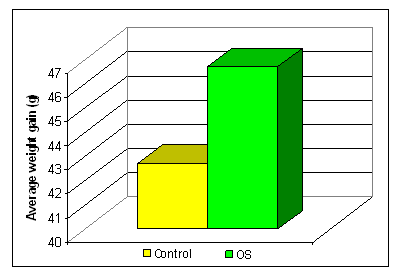

Jintasataporn et al. (2007a) conducted a 12-week trial using Orego-Stim® Aquatract, demonstrating its positive effects on the growth performance of hybrid catfish (Clarias spp.). Results showed that fish fed with Orego-Stim® Aquatract had a higher body weight compared to both positive and negative control groups, with a significant increase in body weight by 10.7 per cent and 11.7 per cent respectively (Figure 4).
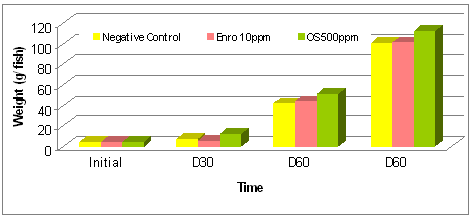
A more efficient feed conversion ratio was also observed in the Orego-Stim® Aquatract group, which was 6.38 per cent and 4.96 per cent lower than both positive and negative control groups respectively (Figure 5).
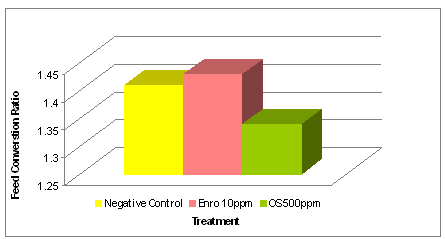
Orego-Stim® Aquatract also revealed contrasting antimicrobial activity against pathogenic and beneficial bacteria (Jintasataporn et al., 2007a). In contrary to a common misconception that Orego-Stim® may also inhibit the growth of beneficial bacteria, this study proved otherwise. The following results show that Orego-Stim® Aquatract was able to increase the numbers of lactic acid producing bacteria such as Lactobacillus spp. in the gastrointestinal microbiota by up to 62.5 per cent compared to the negative control group, whilst reducing populations of pathogens such as Aeromonas spp., a bacterial species that commonly affects freshwater fish (Figure 6).
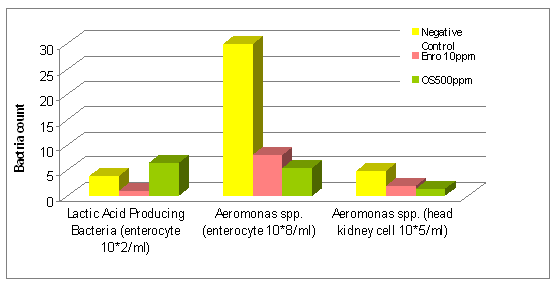
The Use of Orego-Stim® Aquatract in Shrimp Production
Improvements in feed conversion efficiency and survival rates were also reported in shrimps. A four-month commercial trial conducted in Ecuador demonstrated improvements in feed conversion by 19.8 per cent (Figure 7) and survival rates by 6.5 per cent (Figure 8) by adding Orego-Stim® Aquatract to the diet of shrimps, compared to the control group, which were fed the same diet but without the inclusion of Orego-Stim® Aquatract. The results clearly indicated how Orego-Stim® Aquatract could improve shrimp farming production systems compared to conventional rearing systems (Merchan, 2005).
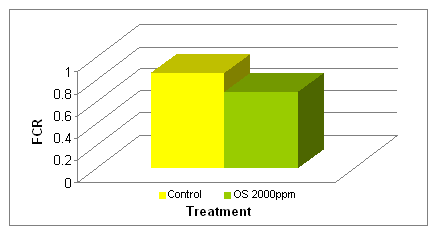
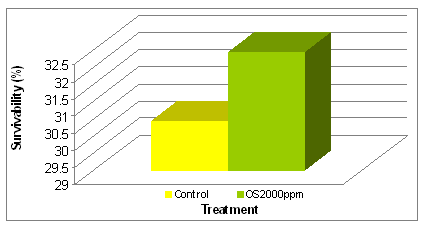
Jintasataporn et al. (2007b) also conducted a three-month trial in white shrimps (Litopenaeus vannamei) and discovered that by using Orego-Stim® Aquatract at 1000 ppm, the prophenoloxidase activity was increased by 170 per cent (or 2.7 times) and 69 per cent (or 1.7 times) higher than that of the control and enrofloxacin groups respectively (Figure 9). The prophenoloxidase-activating system is a major innate defense mechanism of invertebrates and prophenoloxidase activity is a good indicator of shrimp immunity.
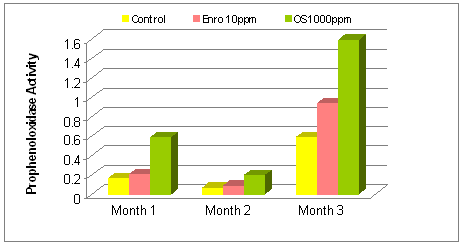
Further evaluation was carried out to determine the relationship between the increased prophenoloxidase activity and disease resistance in shrimp. The shrimps were subjected to virulent Vibrio harveyi challenge after the initial three-month growth promotion trial. Results showed that Orego-Stim® Aquatract had a protective effect on the shrimp, resulting in a significantly lower mortality rate of 36.67 per cent in comparison with the negative control group and the enrofloxacin group, which had mortality rates of 56.67 per cent and 53.33 per cent respectively (Table 1).
| Parameter | Control | Enrofloxacin 10 ppm | OS 2000 ppm |
| Survivability ( per cent) | 43.33 | 46.67 | 63.33 |
| Mortality ( per cent) | 56.67 | 53.33 | 53.33 |
Similar and corresponding to the aforementioned catfish trial, higher levels of oregano essential oil, albeit being a potent antibacterial agent, did not exert detrimental effects on lactic acid producing bacteria such as Lactobacillus spp. although on the other hand, bacterial load and Vibrio spp. counts were markedly reduced in the Orego-Stim® Aquatract 2000 ppm group compared to the negative control and enrofloxacin groups (Figure 10). This finding clearly explains the increased survivability rate in shrimps with the use of the higher inclusion rates of Orego-Stim® Aquatract during critical periods and times of stress and disease challenge.
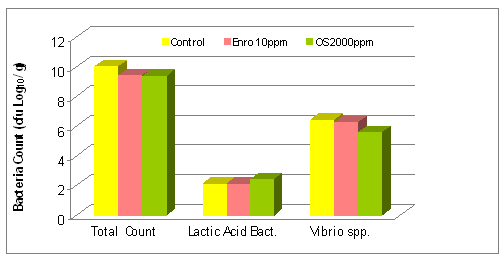
Conclusion
The use of Orego-Stim® Aquatract has been proven to be effective in enhancing growth performance, improving the immune status and preventing the occurrence of diseases in both fin-fish and shrimps.
However, it must be noted that not all phytobiotics offer the same benefits or efficacy in terms of results and productivity. Due to the differences that can be found in the levels and ratios of active chemical constituents of the many, diverse plant extracts, the variance in bioavailability and bioactivity of these active components may result in differing performances from those reported (Jin et al., 2008). As there are more than 30 different active components that are naturally found in pure oregano essential oil, it is highly likely that these other minor constituents play an important role in the efficacy of Orego-Stim® Aquatract, as there is evidence that the antimicrobial activity of whole, unadulterated oregano essential oil is greater than the additive effect of its major antimicrobial components (Lattaoui and Tantaoui-Elaraki, 1994).
It is also crucial to note that commercially available "nature identical" versions of oregano essential oil require a degree of purity of not less than 99.5 per cent in order to comply with food legislation (Ariza-Nieto, 2005). Any degree of purity that is less than this would not be deemed suitable for entry into the human food chain. Therefore, it is crucial for nutritionists and feed producers to consider these facts when choosing from a range of phytobiotic or essential oil feed additives for improving aquaculture production, to ensure compliance with standard food safety regulations on a global scale.
References
Ariza-Nieto, C.J., 2005, ‘Evaluation of Oregano (Origanum vulgare) Essential Oil in Swine Production System’, Doctoral Thesis, University of Minnesota, United States of America.
Di Pasqua, R., De Feo, V., Villani, F. & Mauriello, G., 2005. ‘In vitro antimicrobial activity of essential oils from Mediterranean Apiaceae, Verbenaceae and Lamiaceae against foodborne pathogens and spoilage bacteria,’ Annals of Microbiol., Vol. 55(2), pp. 139-143.
Hammer, K.A., Carson, C.F. & Riley, T.V., 1999, ‘Antimicrobial activity of essential oils and other plant extracts,’ J. Appl. Microb., Vol. 86, pp. 985-990.
Jin, L.Z. & Lan, G.Q., 2008, ‘The research application of plant extract feed additives in swine production’, Chinese Swine Production Magazine, Vol. 3.
Jintasataporn, O., Areechon, N., Ritchai, N. & Tonedial, C., 2007a, ‘The effect of Orego-Stim® in Catfish’, Unpublished Data, Kasetsart University, Thailand.
Jintasataporn, O., Areechon, N., Ritchai & N., Tonedial, C., 2007b, ‘The effect of Orego-Stim® in White Shrimp Litopenaeus vannamei’, Unpublished Data, Kasetsart University, Thailand.
Lattaoui, N., & A. Tantaoui-Elaraki, 1994. ‘Individual and combined antibacterial activity of the main constituents of three essential oils.’ EPPOS, Vol. 3, pp. 13-19.
Merchan, R., 2005, ‘Effects of Orego-Stim in Shrimp Production: Ecuador Study’, Unpublished Data, Merchan & Fontana Company, Ecuador.
Meriden Animal Health Limited Research & Technical Report, 2007, Unpublished data, United Kingdom
Sivropoulou, A., Papanikolaou, E., Nikolaou, C., Kokkini, S., Lanara, T. & Arsenakis, M., 1996, J. Agrc. Food Chem., Vol. 44, pp. 1202-1205.
Stiles, J.C., Sparks, W. & Ronzio, R. A., 1995, J. Appl. Nutr., Vol. 47, pp. 96-102.
Strand, M.R., 2008, ‘The insect cellular innate response’. Insect Science, Vol. 15, pp. 1-14.

